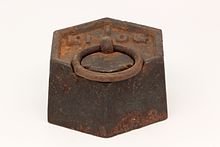
Back Акилограмм Abkhazian Kilogram Afrikaans Kilogramm ALS Kilogramo AN كيلوغرام Arabic كيلوݣرام ARY كيلوجرام ARZ কিলোগ্ৰাম Assamese Quilogramu AST Kilu Aymara
| Kilogram | |
|---|---|
 The mass of this object is 1 kilogram | |
| General information | |
| Unit system | SI base unit |
| Unit of | mass |
| Symbol | kg |
| Conversions | |
| 1 kg in ... | ... is equal to ... |
| Avoirdupois | ≈ 2.205 pounds[a] |
| British Gravitational | ≈ 0.0685 slugs |
The kilogram[b] is the base unit of mass in the International System of Units (SI). It is widely used in science, engineering, and commerce worldwide. The kilogram is exactly the mass of one litre of water.
As of May 20, 2019, the definition of the kilogram is based on the Planck constant as 6.62607015×10−34 kg⋅m2⋅s−1.[1][2]
There are attempts to define the kilogram in other ways. One example specifies a number of atoms of a certain substance (at a certain temperature).
One kilogram is a little more than 2.2 pounds. One tonne is one thousand kilograms. One litre of water weighs almost exactly one kilogram, at 3.98 °C (39.16 °F; 277.13 K), at sea level. This was the basis of the definition of the gram in 1795.
Cite error: There are <ref group=lower-alpha> tags or {{efn}} templates on this page, but the references will not show without a {{reflist|group=lower-alpha}} template or {{notelist}} template (see the help page).
- ↑ Draft Resolution A "On the revision of the International System of units (SI)" to be submitted to the CGPM at its 26th meeting (2018) (PDF), archived from the original (PDF) on 2018-04-29, retrieved 2019-06-21
- ↑ Decision CIPM/105-13 (October 2016). The day is the 144th anniversary of the Metre Convention.